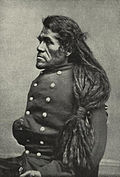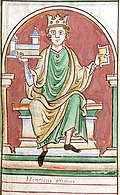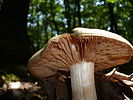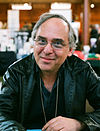Wikipedia:Today's featured article/August 2015
| << | Today's featured articles for August 2015 | >> | ||||
|---|---|---|---|---|---|---|
| Su | Mo | Tu | We | Th | Fr | Sa |
| 1 | ||||||
| 2 | 3 | 4 | 5 | 6 | 7 | 8 |
| 9 | 10 | 11 | 12 | 13 | 14 | 15 |
| 16 | 17 | 18 | 19 | 20 | 21 | 22 |
| 23 | 24 | 25 | 26 | 27 | 28 | 29 |
| 30 | 31 | |||||
August 1
Preparing for a Fancy Dress Ball is an oil painting by English artist William Etty. Although he was then known almost exclusively for history paintings featuring nude figures, he was commissioned in 1833 by Welsh Conservative politician Charles Williams-Wynn to paint a portrait of two of his daughters. Charlotte, the eldest, is shown standing, helping the seated Mary decorate her hair with a ribbon and a rose, both in lavish Italian-style costume. Etty put a good deal of effort into the piece and took much longer than usual to finish it, first exhibiting it at the 1835 Royal Academy Summer Exhibition. Generally well received, even by critics usually hostile to Etty, it demonstrated that he was both capable of high-quality work and deserving of patronage by the English elite, and the success led to further commissions. It remained in the collection of Mary Williams-Wynn's descendants and was not shown publicly for 160 years, other than in an 1849 retrospective exhibition. In 2009 it was acquired by the York Art Gallery, where it now forms part of a major collection of Etty's work. (Full article...)
August 2
How Brown Saw the Baseball Game is a 1907 American short comedy film distributed by Siegmund Lubin's Lubin Manufacturing Company. The film follows Mr. Brown, a baseball fan, who drinks several highball cocktails before arriving at the ballpark. He has become so intoxicated that the baseball game appears to him in reverse motion. During production, trick photography was used to achieve this effect. The film received positive reviews in a 1908 issue of The Moving Picture World, a film journal, that regarded it as successful and "truly funny". The identities of the film's cast and production crew are not known. Film historians have noted similarities between the plot of How Brown Saw the Baseball Game and the comedy film How the Office Boy Saw the Ball Game directed by Edwin S. Porter, released the previous year. (Full article...)
August 3
Irataba (c. 1814 – 1874) was a leader of the Mohave Nation, known as an advocate for peace with whites and a mediator with the United States. He was a renowned orator and one of the first Mohave to speak English. He became the Mohave Nation's Aha macave yaltanack, an elected, as opposed to hereditary, leader. As a result of his many interactions with US officials and settlers, Irataba was invited to Washington, D.C., in 1864 for an official meeting with members of the US military and government, including President Abraham Lincoln. He was the first Native American from the Southwest to meet an American president. Upon his return he negotiated the creation of the Colorado River Indian Reservation, which caused a split in the Mohave Nation when he led several hundred of his supporters to the Colorado River valley. Some historians consider Irataba a great leader who championed peace, but others feel he could have done more to defend the Mohave way of life. In March 2015, Mohave Tribal chairman Dennis Patch credited Irataba with ensuring that "the Mohaves stayed on land they had lived on since time immemorial." (Full article...)
August 4
The Cleveland Bay is a breed of horse that originated in England during the 17th century, named for its consistent bay colouring and the Cleveland district of Yorkshire. It is a strong, well-muscled horse breed, the oldest established breed in England, and the only non-draught horse developed in Great Britain. The ancestors of the breed were developed during the Middle Ages for use as pack horses. These were crossbred with Andalusian and Barb blood, and later with Arabians and Thoroughbreds, to create the Cleveland Bay of today. Over the years, the breed became lighter in frame as they were used more as carriage and riding horses. They have been patronised by members of the royal family throughout their history, and some are still used to pull carriages in royal processions. Today they are used for farm work, driving, and under-saddle work, but are particularly popular for fox hunting and show jumping. The Cleveland Bay is a rare breed, and both the UK-based Rare Breeds Survival Trust and the US-based Livestock Conservancy consider the population to be at critical limits for extinction. (Full article...)
August 5
Henry I (c. 1068 – 1135) was King of England from 1100 to 1135. After his father, William the Conqueror, died in 1087, Henry's older brothers Robert and William Rufus inherited Normandy and England, respectively, while Henry was landless. He seized the English throne after William Rufus's death in 1100, and Robert invaded England to claim it. A settlement between the two confirmed Henry as king, but it was short-lived; Henry invaded Normandy and defeated Robert. Henry's control of Normandy was challenged by William Clito, Robert's son, and a rebellion resulted. Peace only came after Henry's victory at the Battle of Bremule. Considered by contemporaries to be a harsh but effective ruler, Henry drew on the existing Anglo-Saxon system of justice in England and added the exchequer and judges. Normandy was increasingly governed in the same manner. He encouraged the ecclesiastical reforms initiated by Pope Gregory VII, but became involved in a dispute with Archbishop Anselm of Canterbury. Henry's only legitimate son, William Adelin, drowned in the White Ship disaster, causing a succession crisis. Henry declared his daughter, Matilda, as his heir and married her to Geoffrey Plantagenet. After his death, however, Henry was succeeded by his nephew, Stephen, resulting in a civil war known as the Anarchy. (Full article...)
August 6

A gas explosion in a residential area of Rosario, the third-largest city in Argentina, occurred on August 6, 2013. It was caused by a large gas leak; a nearby building collapsed, and others were at high risk of structural failure. Twenty-two people died, and sixty were injured. Several organizations helped secure the area, search for survivors and aid people who lost their homes. The provincial judiciary launched an investigation into the cause of the explosion, and particularly the role of Litoral Gas, the natural-gas provider for Rosario. President Cristina Fernández de Kirchner, who had recently returned from a diplomatic visit to the United Nations, visited the site of the explosion, and most of the candidates for the 2013 primary elections suspended their political campaigns. Pope Francis sent a letter of condolence to the Archbishop of Rosario that was read during a mass and procession for Saint Cajetan at Plaza 25 de Mayo, Rosario's civic center. (Full article...)
August 7
Hurricane Diane, the most destructive storm of the 1955 Atlantic hurricane season, formed on August 7 and reached peak sustained winds of 105 mph (170 km/h) as a Category 2 hurricane five days later. Gradually weakening, it made landfall near Wilmington, North Carolina, as a strong tropical storm on August 17, just five days after Hurricane Connie struck near the same area. After Diane turned northeast, its rain clouds were amplified by moisture coming off warm Atlantic waters. Eastern Pennsylvania suffered record floods, largely in the Poconos and along the Delaware River, that killed 101 people and breached or destroyed 30 dams. Damage was heaviest in Connecticut, where rainfall peaked at 16.86 inches (428 mm); the storm effectively split the state in two by destroying bridges and cutting communications, flooding all major streams and valleys. Record-high tides and flooded rivers heavily damaged Woonsocket, Rhode Island. In Massachusetts, floodwater levels surpassed those during the 1938 Long Island hurricane, breaching multiple dams. Nationwide, Diane killed at least 184 people and destroyed or damaged 15,000 homes. Losses, including lost revenue, topped $1 billion. In the hurricane's wake, eight states were declared federal disaster areas, and the name Diane was retired. (Full article...)
August 8
SMS Kurfürst Friedrich Wilhelm ("His Majesty's Ship Elector Friedrich Wilhelm") was one of the first ocean-going battleships of the Imperial German Navy, the fourth pre-dreadnought of the Brandenburg class. She was laid down in 1890 in the Imperial Dockyard in Wilhelmshaven, launched in 1891, and completed in 1893 at a cost of 11.23 million Marks. She served as the flagship of the Imperial fleet from her commissioning until 1900, seeing limited active duty during the relatively peaceful late 19th and early 20th centuries. Her career focused on training exercises and goodwill visits to foreign ports. She saw only one major overseas deployment, to China in 1900 and 1901, during the Boxer Rebellion. The ship underwent a major modernization in 1904 and 1905. In 1910, Kurfürst Friedrich Wilhelm was sold to the Ottoman Empire and renamed Barbaros Hayreddin. She saw heavy service during the Balkan Wars, primarily providing artillery support to ground forces in Thrace. In a state of severe disrepair, the old battleship was partially disarmed after the Ottoman Empire joined World War I's Central Powers. On 8 August 1915 the ship was torpedoed and sunk off the Dardanelles with heavy loss of life. (Full article...)
Part of the Battleships of Germany featured topic.
August 9
"Love the Way You Lie" is a song recorded by American rapper Eminem with Barbadian singer Rihanna, from Eminem's seventh studio album Recovery (2010). Skylar Grey and Alex da Kid collaborated on a demo of the song, which compares Grey's life in the music industry with an abusive romantic relationship. Eminem rewrote the song and asked Rihanna to sing the chorus, adding his own verses. The song describes two lovers in a dangerous love–hate relationship who refuse to separate. Backed by guitar, piano and violin, the track is a midtempo hip hop ballad with a pop refrain, recorded in Ferndale, Michigan, and Dublin, Ireland. It was released as the second single from Recovery in 2010. Critics praised its melody but were divided over its representation of domestic violence. Its accompanying music video, directed by Joseph Kahn, stars Dominic Monaghan and Megan Fox in a violent relationship, and shows Eminem and Rihanna in front of a burning house. Critics listed "Love the Way You Lie" as one of the best of the year. Eminem's best-selling single, it received several awards and five Grammy nominations. (Full article...)
August 10
Entoloma sinuatum is a poisonous mushroom found across Europe and North America. It is the largest mushroom of the Entoloma genus of pink-spored fungi. Appearing in late summer and autumn, it is found in or near deciduous woodlands on clay or chalky soils, sometimes in the form of fairy rings. The ivory to light grey-brown cap is up to 20 cm (8 in) across with a margin that is rolled inward. The sinuate gills are pale and often yellowish, becoming pink as the spores develop. The thick whitish stem has no ring. When young, it may be mistaken for the edible St George's mushroom (Calocybe gambosa) or the miller mushroom (Clitopilus prunulus). It has been responsible for many cases of mushroom poisoning in Europe, causing primarily gastrointestinal problems that have been described as highly unpleasant. Delirium and depression are uncommon chronic side effects. It is generally not considered to be lethal, although one source has reported deaths from its consumption. (Full article...)
August 11
The Arbiter is a playable character from the Halo science fiction universe, first voiced by Keith David in the 2004 video game Halo 2. A different Arbiter appears in the 2009 real-time strategy game Halo Wars, voiced by David Sobolov. Although the Arbiter is intended to die serving the High Prophets, he survives his missions and the Prophets' subsequent betrayal of his kind. When he learns that the Prophets' plans would doom all sentient life in the galaxy to extinction, he allies with the Covenant's enemies—humanity—to stop the Halo from being activated. The entertainment website IGN lamented the loss of the Arbiter's storyline in Halo 3, but the Arbiter character was not evenly received by critics and fans, nor was the humanization of the Covenant in general. The character's name was changed from "Dervish" to avoid reinforcing a perceived US-versus-Islam allegory in the game's plot. (Full article...)
Part of the Characters of Halo series, one of Wikipedia's featured topics.
August 12
The Smyth Report is the common name of an administrative history written by physicist Henry DeWolf Smyth about the Manhattan Project, the Allied effort to develop atomic bombs during World War II. It was released to the public on August 12, 1945, just days after the atomic bombings of Hiroshima and Nagasaki. Smyth was commissioned to write the report by Major General Leslie Groves, the director of the Manhattan Project. The Smyth Report was the first official account of the development of the atomic bombs and the basic physical processes behind them. Since anything in the declassified Smyth Report could be discussed openly, it focused heavily on basic nuclear physics and other information which was either already widely known in the scientific community or easily deducible by a competent scientist. It omitted details about chemistry, metallurgy, and ordnance, ultimately giving a false impression that the Manhattan Project was all about physics. The Smyth Report sold almost 127,000 copies in its first eight printings, and was on the New York Times best-seller list from mid-October 1945 until late January 1946. It has been translated into over 40 languages. (Full article...)
August 13
Castell Coch is a 19th-century Gothic Revival castle built above the village of Tongwynlais in South Wales. The first castle on the site was built by the Normans after 1081 to protect the newly conquered town of Cardiff. The castle's earth motte was reused by Gilbert de Clare as the basis for a new stone fortification, built between 1267 and 1277. John Crichton-Stuart, 3rd Marquess of Bute, inherited the castle ruins in 1848. One of Britain's wealthiest men, he employed the architect William Burges to reconstruct the castle as a summer residence. Burges rebuilt the outside before his death in 1881, and the interior work was finished by his team in 1891; it featured elaborate decorations including extensive use of symbolism drawing on classical mythology and legendary themes. Crichton-Stuart planted a vineyard just below the castle, where wine production continued until the First World War. In 1950 his grandson, the 5th Marquess of Bute, placed the property into the care of the state. Castell Coch is considered to be one of the best surviving examples of Victorian architecture. (Full article...)
August 14
Terns are seabirds in the family Sternidae that are found worldwide, generally near the sea, rivers or wetlands. They are slender, lightly built birds with long forked tails, narrow wings, long bills and relatively short legs. Most species are pale grey above and white below, with a contrasting black cap, but the marsh terns, the Inca tern and some noddies have dark plumage for at least part of the year. The sexes are identical in appearance. They are birds of open habitats that typically breed in noisy colonies and lay their eggs on bare ground with little or no nest material. Many terns are long-distance migrants, and the Arctic tern, migrating each year between the Arctic and Antarctic, may see more daylight in a year than any other animal. They are long-lived birds and are relatively free from natural predators and parasites, but most species are declining in numbers through habitat loss, polluted waters, human encroachment and predation by introduced mammals. Three tern species are classed as endangered, and the Chinese crested tern is critically endangered. International agreements provide a measure of protection, but adults and eggs of some species are still used for food in the tropics. (Full article...)
August 15

Departures is a Japanese drama film directed by Yōjirō Takita and starring Masahiro Motoki, Ryōko Hirosue, and Tsutomu Yamazaki. Loosely based on Shinmon Aoki's memoir Coffinman, the film follows a young man who becomes a nōkanshi—a traditional Japanese ritual mortician—and overcomes the prejudices of those around him. The story was conceived after Motoki, affected by a funeral ceremony he had seen along the Ganges, read Coffinman and felt that the story would adapt well to film. Departures took a decade to complete, and distributors released it only after the film won the grand prize at the Montreal World Film Festival in August 2008. It became Japan's highest-grossing domestic film that year and won numerous awards, including the first Academy Award for Best Foreign Language Film for Japan. It was praised for its humour and the beauty of the encoffining ceremony (set pictured), but critics took issue with the film's predictability and overt sentimentality. The film's success spurred the development of tourist attractions at its shooting sites, increased interest in encoffining ceremonies, and the adaptation of the story for various media. (Full article...)
August 16

Corona Borealis, the Northern Crown, and Corona Australis, the Southern Crown, are two small constellations among the 48 listed by the 2nd-century astronomer Ptolemy. Corona Borealis, which generally represented the crown given by the god Dionysus to the Cretan princess Ariadne, is in the Northern Celestial Hemisphere, while Corona Australis, associated with Sagittarius or Centaurus, is in the Southern. Corona Borealis boasts the highly variable stars R and T Coronae Borealis and the huge Corona Borealis Supercluster. Corona Australis, lying alongside the plane of the Milky Way, hosts Epsilon Coronae Australis, the brightest example of a W Ursae Majoris variable in the southern sky. It also contains one of the closest star-forming regions to our Solar System, about 430 light years away—a dusty dark nebula known as the Corona Australis Molecular Cloud, with stars at their earliest stages. (See Corona Borealis and Corona Australis.)
August 17
Supernature is the third studio album by English electronic music duo Goldfrapp, released on 17 August 2005 by Mute Records. Its blend of pop and electronic dance music was complimented by most critics. Supernature debuted at number two on the UK Albums Chart, selling 52,976 copies in its first week. It was certified platinum by the British Phonographic Industry (BPI) in January 2006, and had sold one million copies worldwide as of February 2008. The album spawned four singles: "Number 1", "Ride a White Horse", "Fly Me Away", and its lead single, "Ooh La La", which reached number four on the UK Singles Chart, becoming the duo's highest-peaking single to date. In North America, where "Number 1" was promoted as the first single, the album was released in 2006 and did not perform well on the charts. Supernature received a Grammy Award nomination for best electronic/dance album in 2007. (Full article...)
August 18
Ruby Laffoon (1869–1941) was an American politician and the 43rd governor of Kentucky, from 1931 to 1935. At age 17, Laffoon moved to Washington, D.C. to live with his uncle, U.S. Representative Polk Laffoon. In 1931, he defeated Republican William B. Harrison by what was then the largest margin of victory ever in a Kentucky gubernatorial election. To make up for a revenue shortfall during the Great Depression, Laffoon advocated the enactment of the state's first sales tax. This issue dominated most of his term in office and split the state Democratic Party and his own administration; the tax was defeated three times before he forged a bipartisan alliance to get it passed in a special legislative session in 1934. Term-limited by the state constitution, Laffoon supported political boss Tom Rhea to succeed him as governor, but Rhea was beaten by Lieutenant Governor Happy Chandler in the primary. Laffoon appointed a record number of Kentucky colonels, including Harland Sanders, who used the title "Colonel" when he opened his chain of Kentucky Fried Chicken restaurants. (Full article...)
August 19
The hermeneutic style of Latin, a style with many unusual and arcane words, especially from Greek, became the nearly universal preference in tenth-century England. It was first found in the work of Apuleius in the second century and then in Europe in the later Roman period. In the early medieval period some leading Continental scholars were exponents, including Johannes Scotus Eriugena and Odo of Cluny; the most influential hermeneutic writer was the English seventh-century bishop Aldhelm. In England the hermeneutic style became increasingly influential in the tenth century when Latin scholarship was reviving; in continental Europe, the style was only ever used by a minority of writers. It was the house style of the English Benedictine Reform, the most important intellectual movement in later Anglo-Saxon England. The style fell out of favour after the Norman Conquest, and the twelfth-century chronicler William of Malmesbury described it as disgusting and bombastic. Historians were equally dismissive until the late twentieth century, when scholars such as Michael Lapidge argued that it should be taken seriously as an important aspect of late Anglo-Saxon culture. (Full article...)
August 20

The Battle of Grand Port was a naval battle between frigates from the French Navy and the British Royal Navy, fought in August 1810 to control the harbour of Grand Port on Isle de France (now Mauritius) during the Napoleonic Wars. The British squadron of four frigates sought to blockade the port, but four of the five French ships managed to break past the blockade. They took shelter in a protected anchorage that was only accessible through a series of complicated reefs and sandbanks, requiring an experienced harbour pilot. When the British commander, Samuel Pym, ordered his frigates to attack, they became trapped in the narrow channels of the bay: two were irretrievably grounded, a third was outnumbered and defeated, and a fourth, unable to close within effective gun range, was later seized as it left the harbour. Although the French ships were also badly damaged, the defeat was the worst the Royal Navy suffered during the entire war, and it left the Indian Ocean and its vital trade convoys exposed to attack from Commodore Jacques Hamelin's frigates. In December a strong British battle squadron under Admiral Albemarle Bertie rapidly invaded and subdued Isle de France. (Full article...)
August 21
Seorsumuscardinus, a genus of European dormice identified by fossils, lived around 17 million years ago during the early Miocene. Fossils from one species, S. alpinus, have been taken from rock strata in Oberdorf am Hochegg in Austria, Karydia in Greece, and Tägernaustrasse in Switzerland. A second species, S. bolligeri, was found at a single site in Affalterbach, Germany. Identified from many isolated teeth, both species were medium-sized dormice, with flat teeth characterized by long transverse crests coupled with shorter ones. Seorsumuscardinus may be related to Muscardinus, the genus of the living hazel dormouse, which appears in the fossil record at about the same time, and the older Glirudinus. Because the two known species lived at different times, the paleontologist Jerome Prieto has suggested that the genus may be useful for biostratigraphy, the use of fossils to determine the age of deposits. (Full article...)
August 22
Maus is a graphic novel by American cartoonist Art Spiegelman (pictured in 2007), serialized from 1980 to 1991. It depicts Spiegelman interviewing his father, a Polish Jew and Holocaust survivor. The book is self-referential and postmodern—most strikingly in its depiction of Jews as mice, Germans as cats, and non-Jewish Poles as pigs. The narrative consists mostly of flashbacks to the war years, framed by the interview that takes place in 1978 in the Rego Park section of New York City. Much of the story revolves around Spiegelman's troubled relationship with his father, and the impact of his mother's suicide when he was 20. The book uses a minimalist drawing style with innovative page and panel layouts, pacing, and structure. Maus was serialized as an insert in Raw, an avant-garde comics and graphics magazine published by Spiegelman and his wife, Françoise Mouly. It was one of the first graphic novels to receive significant academic attention in the English-speaking world, and in 1992 became the first to win a Pulitzer Prize. (Full article...)
August 23

The Queen Elizabeth Way is a 400-Series highway in the Canadian province of Ontario linking Toronto with the Niagara Peninsula and Buffalo, New York. The freeway begins at the Peace Bridge in Fort Erie and travels 139.1 kilometres (86.4 mi) around the western shore of Lake Ontario, ending at Highway 427, where the roadway continues as the Gardiner Expressway into downtown Toronto. The freeway's history dates back to 1931, when work began to widen the Middle Road as a relief project during the Great Depression, to bring it up to the quality of the nearby Dundas Highway and Lakeshore Road. In 1934, the design was modified to resemble German autobahns. It was the first intercity divided highway in North America in 1937 and featured the longest stretch of consistent illumination in the world. While not a true freeway at the time, it was gradually upgraded, widened and modernized beginning in the 1950s, taking on more or less its current form by 1975. Since then, various projects have continued to widen the route. (Full article...)
August 24
Jethro Sumner (c. 1733 – 1785) was an officer in the Continental Army during the American Revolutionary War. After serving in Virginia's Provincial forces in the French and Indian War and later as Sheriff of Bute County, North Carolina, he became a strident Patriot, and was elected to North Carolina's Provincial Congress. He was named the commanding officer of the 3rd North Carolina Regiment in the Continental Army in 1776, seeing action in the Southern theater and Philadelphia campaign. One of five brigadier generals from North Carolina, he served with distinction in the battles of Stono Ferry and Eutaw Springs, but recurring bouts of poor health often forced him to play an administrative role, or to convalesce back home. Following a drastic reduction in the number of North Carolinians serving with the Continental Army, Sumner became a general in the state's militia, but resigned in protest after the state Board of War awarded overall command of the militia to William Smallwood, a Continental Army general from Maryland. In 1783 Sumner helped establish the state chapter of the Society of the Cincinnati, and became its first president. He died in 1785 with extensive landholdings. (Full article...)
August 25
Caloboletus calopus, known as the bitter beech bolete, is a fungus of the bolete family, found in Asia, Northern Europe and North America. Appearing in coniferous and deciduous woodland in summer and autumn, the stout mushrooms are attractively coloured, with a beige to olive cap up to 15 cm (6 in) across, yellow pores, and a reddish stalk up to 15 cm (6 in) long and 5 cm (2 in) wide. The pale yellow flesh stains blue when broken or bruised. Christian Persoon first described Boletus calopus in 1801. Modern molecular phylogenetics has shown that it is only distantly related to the type species of Boletus, and it was placed in a new genus as the type species of Caloboletus in 2014. It is not an edible mushroom, rendered unpalatable by its intensely bitter taste, which does not disappear with cooking. Its red stalk distinguishes it from edible species such as Boletus edulis. (Full article...)
August 26
Pather Panchali is a 1955 Bengali drama film adapted from Bibhutibhushan Bandopadhyay's 1929 Bengali novel of the same name. The debut film of the Indian director Satyajit Ray, it depicts the lives of a family from a poor Indian village with two children, Apu (Subir Banerjee) and his elder sister Durga (Uma Dasgupta). The film, shot mainly on location in rural India, took nearly three years to complete. Sitar virtuoso Ravi Shankar composed the score. After a screening in May at New York's Museum of Modern Art, it was officially released in Kolkata on August 26, 1955, and was enthusiastically received after a slow start. Many critics have praised the film's realism and humanity, though a few have found fault with its slow pace; other critics have condemned it, claiming it romanticizes poverty. The tale of Apu's life is continued in Aparajito (The Unvanquished, 1956) and Apur Sansar (The World of Apu, 1959). The three films constitute the Apu Trilogy. Pather Panchali was a pioneer film of the Parallel Cinema movement and was the first film from independent India to attract major international attention, winning a number of awards and establishing Ray as a major director. It has been featured in lists of the greatest films ever made. (Full article...)
August 27
Jim Thome (born 1970) is a retired American baseball player who spent 22 seasons in Major League Baseball. He started with the Cleveland Indians in 1991 and joined the Philadelphia Phillies in 2002. Traded to the Chicago White Sox before the 2006 season, he won the American League Comeback Player of the Year Award that year. After back pain limited him to being a designated hitter, he had stints with the Los Angeles Dodgers, Minnesota Twins, Indians and Phillies before ending his career with the Baltimore Orioles. A prolific power hitter, Thome hit 612 home runs during his career—the seventh-most of all time. He was a member of five All-Star teams and won a Silver Slugger Award in 1996. One of his trademarks was his unique batting stance, pointing the bat at right field before the pitcher threw, something he first saw in the film The Natural. He was known for his consistent positive attitude and gregarious personality. An active philanthropist during his playing career, he was honored with two Marvin Miller Man of the Year Awards and a Lou Gehrig Memorial Award. (Full article...)
August 28
The American twenty-cent piece was a coin struck from 1875 to 1878, but only for collectors in the final two years. In 1874 Nevada's newly elected senator, John P. Jones, began promoting his bill for a twenty-cent piece to alleviate the shortage of small change in the Far West. The bill passed Congress the following year, and Mint Director Henry Linderman ordered pattern coins struck. Although the new coin's edge was smooth rather than reeded, as with other silver coins, the new piece was close to the size of, and immediately confused with, the quarter. Adding to the bewilderment, the obverses (front faces) of the coins were almost identical. After the first year, in which over a million were minted, there was little demand, and the denomination was abolished in 1878. At least a third of the total mintage was later melted by the government. Numismatist Mark Benvenuto called the twenty-cent piece "a chapter of U.S. coinage history that closed almost before it began". (Full article...)
August 29
Birchington-on-Sea is a village and seaside resort in north-east Kent, England, with a population of around 10,000. It faces the North Sea, east of the Thames Estuary, between Herne Bay and Margate. Its main beach is Minnis Bay (pictured); three smaller beaches are surrounded by chalk cliffs, cliff stacks and caves. Roman and prehistoric artefacts indicate that the area was inhabited before the existence of the village, and Minnis Bay was once the site of an Iron Age settlement. The village was first recorded in 1240. Its parish church, All Saints', dates to the 13th century and its churchyard is the burial place of the 19th-century Pre-Raphaelite artist, Dante Gabriel Rossetti. Quex Park, a local 19th-century manor house, is home to the Powell-Cotton Museum and a twelve-bell tower built for change ringing. The museum displays stuffed exotic animals collected by Major Percy Powell-Cotton on his travels in Africa, and houses artefacts unearthed in and around Birchington. (Full article...)
August 30
Judah Benjamin (1811–1884) was a lawyer and United States Senator from Louisiana, a Cabinet officer of the Confederate States and, after his escape to the United Kingdom at the end of the American Civil War, an English barrister. He was the first person professing the Jewish faith to be elected to the Senate, and the first Jew to hold a cabinet position in North America. After attending Yale, Benjamin moved to New Orleans, where he read law and passed the bar. He rose rapidly both at the bar and in politics, becoming a wealthy slaveowner, and serving in both houses of the Louisiana legislature prior to his election to the Senate in 1852. There, he was an ardent supporter of slavery. When war began, Confederate President Jefferson Davis appointed him Attorney General, and later Secretary of War. Made Secretary of State in 1862, Benjamin unsuccessfully tried to gain recognition of the Confederacy by France and the United Kingdom. When Davis fled from Virginia in early 1865, Benjamin went with him. He escaped to Britain and settled there, becoming a barrister and again rising to the top of his profession before retiring in 1883. He died in Paris the following year. (Full article...)
August 31
Carrow Road is a football stadium located in Norwich, Norfolk, England, and is the home of Norwich City Football Club. The stadium is on the east side of the city, not far from Norwich railway station and the River Wensum. The club originally played at Newmarket Road before moving to The Nest. When The Nest was deemed inadequate for the size of crowds it was attracting, the Carrow Road ground, named after the road on which it is located, was purpose-built by Norwich City in just 82 days and opened on 31 August 1935. The stadium has been altered and upgraded several times during its history, including after a devastating fire that destroyed the old City Stand in 1984. Having once accommodated standing supporters, the ground has been all-seater since 1992, with a current capacity of 27,244. The stadium's record attendance since becoming an all-seater ground is 27,036, set during a Premier League match versus Crystal Palace on 8 August 2015. When standing on the terraces was permitted, Carrow Road saw a crowd of 43,984 when hosting Leicester City for an FA Cup match in 1963. Carrow Road has also hosted under-21 international football and a number of concerts, including performances by Elton John and George Michael. (Full article...)
























